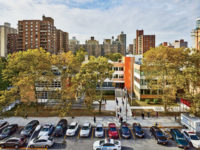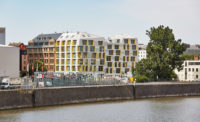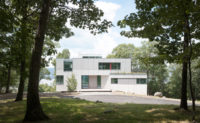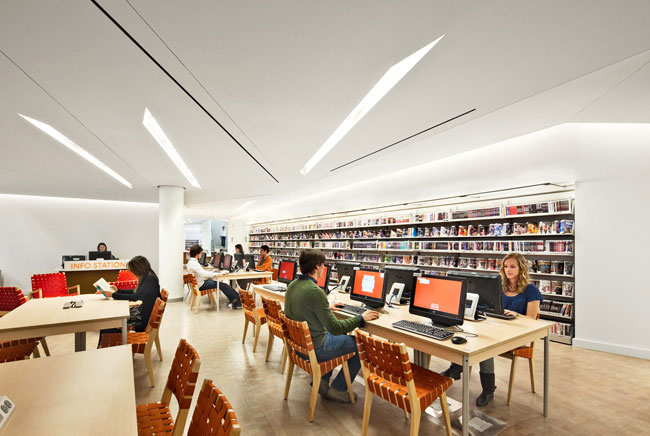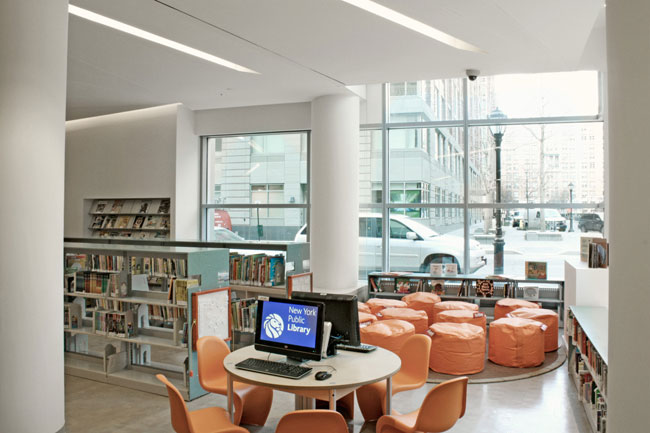Battery Park City Library by 1100 Architect
New York City












Architects & Firms
About 40 years ago, bedrock and dirt were excavated to build the World Trade Center in Lower Manhattan. That soil established the foundation for a 92-acre swath of land where the mixed-use neighborhood of Battery Park City was built. Landfill reuse is a fitting beginning for a planned community that today has become one of the greenest in America, due to stringent environmental guidelines developed in 1999 and implemented by the Battery Park City Authority (BPCA). It is appropriate that the most eco-friendly branch of the 89 public libraries of the New York system would be built here. While the residents in this surprisingly leafy neighborhood have their share of parks, offices, restaurants, and water views, they sorely needed a library.
Additional Content:
Jump to credits & specifications
Designed by 1100 Architect and completed in 2010, the Battery Park City Library occupies the bottom two floors of the northeast corner of a 32-story residential tower called Riverhouse, completed the same year by Polshek Partnership (recently renamed Ennead Architects). In addition to the library, two other nonprofits — Poets House and Mercy Corps — occupy portions of the ground floor of the horseshoe-shaped building. As part of an “amenity program,” the BPCA leases space to nonprofits for $1 a year, a bargain by any measure. Still, the nonprofits have to raise money for construction. “Commitments by councilmen and City Hall, and a substantial donation from Goldman Sachs, were the tipping points that allowed the library to move forward,” says Juergen Riehm, who, along with David Piscuskas, is a partner at the 37-person, 28-year-old 1100 Architect.
Fortunately, the design of Riverhouse was still underway when the library project began. “We were able to convince the developer to modify the facade design to have the library’s frontage wrap around the corner as a double-height glass element, making it really visible and maximizing light coming in and views going out,” says Riehm. This vaulted space became the defining feature of the 10,500-square-foot library, soaring above the street corner to establish a distinctive and inviting presence.
Once inside, visitors discover how the library wraps around an outdoor courtyard, an extension of Michael Van Valkenburgh’s Teardrop Park, which opened a few years before. Windows that overlook the landscape create a link to the outdoors, while the curved plan establishes two main areas on the library’s first floor. The area to the left of the entry accommodates the adult and young adult collections, multimedia, and computer stations, tucked behind a welcoming information and checkout area. To the right, the children’s section occupies the brightly lit double-height street frontage.
A dramatic winding stair serves as a modern sculptural element in the main library space and connects the ground floor to the mezzanine level, where the architects located an event space and reading rooms. Under the sweeping belly of the stair, an intimate seating area covered in orange fabric defines the edge of the children’s library and introduces a touch of color that is picked up in other spaces. Color and navigational cues establish easy-to-follow circulation patterns for people visiting the library for the first time. “The architecture intuitively suggests wayfinding systems through visual connections,” says Riehm.
Since the apartments above the library required space for plumbing lines, 1100 Architect devised an irregularly vaulted ceiling over the two wings of the library that radiate out from the central core like an asymmetrical umbrella.
“To accentuate this dynamic we designed a ceiling with a topography that becomes a unifying element throughout the space,” explains Riehm. “We inserted off-the-shelf fluorescent fixtures into ‘slash cuts’ in the triangulated ceiling, turning a design element into a functional one.”
Today’s libraries cannot simply contain stacks and reading rooms. They must also address the vastly different ways people receive and view information. The Battery Park City Library provides automated checkout, Wi-Fi, computer workstations, an area fit out for multimedia presentations, and a digital dashboard that monitors and displays the facility’s real-time energy performance. The architects employed a number of sustainable design elements including energy-efficient lighting, low- and non-VOC finishes, dual-flush toilets, waterless urinals, and numerous recycled materials. They also specified floors made from gray-stained reclaimed fir end-grain discarded from window manufacturers and carpet made from recycled tires. When Riverhouse completes the paperwork, both the library and building will be on track to receive LEED Gold certification.
An area of contrasts, Lower Manhattan serves as home to numerous financial institutions, a mixed-use residential community, and a place where tourists come to pay respects to Ground Zero, the former site of the World Trade Center. This indelible reminder of the fragility of buildings — and the people who occupy them — is an apt juxtaposition to the optimism and resilience evident in Battery Park City’s new community library.
Completion Date: June 2010
Gross square footage: 10,500 sq.ft.
Total construction cost: $4.4 million
CreditsArchitect: Robert Young Architects
Personnel in architect's firm who should receive special credit: Principal in Charge: Robert Young, AIA, RA Sophie Girard
Architect of record: Robert Young, AIA, RA
Interior designer: Robert Young Architects
Engineers: Becker Engineering, PC - Electrical and Plumbing
Consultants: Audio Interiors, Inc. - Audio Visual Systems
General contractor: Men at Work Construction Corp
Photographer: Michael Moran, 718-237-8830 |
SpecificationsStructural System wood and steel Manufacturer of any structural components unique to this project: Murus Structural Insulated Panels - roof
Exterior Cladding Rainscreen: rough sawn western red cedar planks Moisture barrier: Solitex Mento Black Weather Barrier
Roofing Elastomeric: EPDM roofing by Grace Metal: zinc standing seam by Rhinezinc
Windows Wood frame: Dynamic
Doors Sliding doors: Dynamic
Hardware Locksets: Baldwin Pulls: Sun Valley Bronze
Interior Finishes Paints and stains: Benjamin Moore Paneling: white pine, painted Floor and wall tile: Walker Zanger - Arabescato marble countertop - kitchen Special interior finishes unique to this project: white oak floors from Madera Trade Furnishings Other furniture: 1ST DIBS (MORRISTOWN MODERN) Lighting Interior ambient lighting: A&L Lighting Downlights: Architectural Lighting Works Tasklighting: Brendan Ravenhill Exterior: BEGA Dimming system or other lighting controls: Lutron
Plumbing American Standard
Energy Energy management or building automation system: Zehnder Comfoair 550 ERV |


